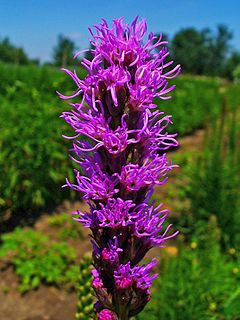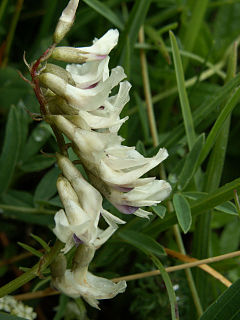
Liatris is a genus of flowering plants in the boneset tribe within the sunflower family native to North America. Its most common name is blazing star. Some species are used as ornamental plants, sometimes in flower bouquets.

Senecio ampullaceus, also known as Texas ragwort, Texas squaw-weed, Texas groundsel, and Texas butterweed, is a species of Senecio in the family Asteraceae, receiving its Latin name ampullaceus from its flask shaped flower-head. It is recommended for landscape use in its native Texas.

Stellaria graminea is a species of flowering plant in the family Caryophyllaceae known by the common names common starwort, grass-leaved stitchwort, lesser stitchwort and grass-like starwort.

Liatris spicata, the dense blazing star or prairie gay feather, is an herbaceous perennial flowering plant in the sunflower and daisy family Asteraceae. It is native to eastern North America where it grows in moist prairies and sedge meadows.

Agoseris grandiflora is a North American species of flowering plant in the daisy family known by the common names California dandelion, bigflower agoseris, and grassland agoseris.
Liatris acidota, also known as the Gulf Coast gayfeather, sharp blazing star and sharp gayfeather, is a plant species in the aster family Asteraceae and genus Liatris. It is native to Louisiana and Texas in the United States, where it is found in habitats that include coastal prairies, dry prairie and savanna, where it is found in sandy to clay soils.

Liatris aestivalis, also known as the summer gayfeather, is a plant species in the aster family Asteraceae and genus Liatris. The specific epithet, aestivalis, is derived from Latin and means "pertaining to the summer". It is native to Oklahoma and Texas in the United States, where it is found in habitats that range from limestone outcrops to slopes and bases of slopes with shallow soils.

Liatris chapmanii, also known as Chapman's blazing star or Chapman's gayfeather, is a plant species in the aster family Asteraceae and genus Liatris. It is native to Alabama, Florida and Georgia in the United States, where it is found in habitats such as dunes, beach strands, sand ridges, fields and roadsides, it also grows in longleaf pine savannas and other scrub habitats.
Liatris cokeri, also known as Coker's gayfeather and sandhills blazing star, is a plant species in the aster family Asteraceae and genus Liatris. It is native to North and South Carolina in the United States, where it is found in habitats such as sand ridges and sandy fields to roadsides; it is also found in turkey-oak and longleaf pine-oak plant communities. It blooms in late summer with purple flower heads.

Liatris compacta, sometimes called Arkansas gayfeather, is a herbaceous plant species in the sunflower family and genus Liatris. It is native to the Ouachitas of west-central Arkansas and eastern Oklahoma in the central United States, where it is found growing in habitats such as rocky ridges, bluffs, hillsides, weathered sandstone, and open woods. It blooms in June to September and may start blooming as early as May, it has purple flowers grouped into heads. It was known as a variety of Liatris squarrosa as Liatris squarrosa var. compacta until relatively recently.

Liatris cylindracea is a plant species in the aster family. It is native to eastern North America, where its populations are concentrated in the Midwestern United States. It is found in habitats such as prairies, limestone and sandstone outcroppings, bluffs, barrens, glades, woodlands and dunes.
Liatris cymosa, also known as Aggie-land gayfeather or branched blazing star, is a plant species in the aster family Asteraceae and genus Liatris. It is native to east central Texas in North America, where it is found in habitats such as post oak woodlands, fields, fence rows, woodland openings and edges, in clay soils. It blooms in mid to late summer with purple flower heads. It is of conservation concern.
Eriophyllum ambiguum is a species of flowering plant in the aster family known by the common name beautiful woolly sunflower. It is native to the deserts and adjacent hills of southern and eastern California, northwestern Arizona, and southern Nevada.

Najas marina is a species of aquatic plant known by the common names spiny water nymph, spiny naiad and holly-leaved naiad. It is an extremely widespread species, reported across Europe, Asia, Africa, Australia, the Americas and many oceanic islands. It can be found in many types of freshwater and brackish aquatic habitat, including bodies of alkaline water.

Solidago spithamaea is a species of flowering plant in the aster family known by the common name Blue Ridge goldenrod. It is native to a very small region around the border between North Carolina and Tennessee in the United States. Its three remaining populations are threatened by the loss and degradation of its habitat. It is a federally listed threatened species of the United States.

Liatris punctata is a species of flowering plant in the aster family known by the common names dotted gayfeather, dotted blazingstar, and narrow-leaved blazingstar. It is native to North America, where it occurs throughout the plains of central Canada, the central United States, and northern Mexico.

Astragalus australis is a species of flowering plant in the legume family known by the common name Indian milkvetch. It is native to much of the Northern Hemisphere, including northern North America, Europe, and temperate Asia.
Atriplex acanthocarpa is a species of flowering plant in the amaranth family known by the common names armed saltbush, tubercled saltbush, and huaha. It is native to North America, where it is limited to the US states of Arizona, New Mexico, and Texas, and adjacent Mexico.

Astragalus iodanthus is a species of flowering plant in the legume family, Fabaceae, known by the common names Humboldt River milkvetch and violet milkvetch. It is native to the western United States, where its range includes California, Idaho, Nevada, Oregon, and Utah. It grows on hills and in valleys in barren sandy and volcanic soils in habitat such as sagebrush.

Pyrrocoma liatriformis is a species of flowering plant in the aster family. Its common names include Palouse goldenweed and smallhead goldenweed. It is native to the northwestern United States, where it is endemic to the Palouse prairie, growing in grassland dominated by blue bunchgrass. It is a perennial herb growing from a taproot, producing one to three stems up to 70 centimeters in length. The stems are erect and hairy. Leaves near the base of the plant are larger and rounder than the leaves connected to the stem, which are lanceolate and hairy. Basal leaves measure 80–310 millimeters long and 9–30 millimeters wide, whereas cauline leaves measure 30–120 millimeters long and 5–20 millimeters wide. The inflorescence is four to five heads arranged in a raceme. Each head is composed of 17–25 yellow ray florets, each 6–14.5 millimeters in length, as well as 35–60 disc florets, each 7–11 millimeters in length.
















